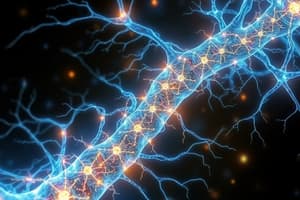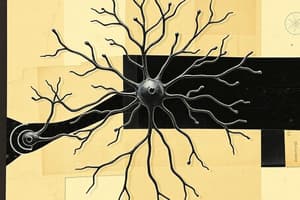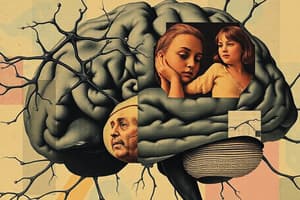Podcast
Questions and Answers
Which function of the nervous system involves monitoring changes occurring inside and outside the body?
Which function of the nervous system involves monitoring changes occurring inside and outside the body?
- Behavior
- Integration
- Motor output
- Sensory input (correct)
What type of neuron conducts impulses from sensory receptors to the central nervous system?
What type of neuron conducts impulses from sensory receptors to the central nervous system?
- Motor neurons
- Sensory neurons (correct)
- Efferent neurons
- Interneurons
Which part of the nervous system is responsible for involuntary control of smooth muscle and glands?
Which part of the nervous system is responsible for involuntary control of smooth muscle and glands?
- Somatic nervous system
- Autonomic nervous system (correct)
- Central nervous system
- Sympathetic nervous system
What is the primary role of interneurons in the nervous system?
What is the primary role of interneurons in the nervous system?
Which structure is defined as a bundle of axons located outside of the brain and spinal cord?
Which structure is defined as a bundle of axons located outside of the brain and spinal cord?
In terms of functional classification, which type of neuron would be involved in voluntary muscle movements?
In terms of functional classification, which type of neuron would be involved in voluntary muscle movements?
What describes the function of the
What describes the function of the
Which component of the central nervous system contains a group of neurons with similar functions?
Which component of the central nervous system contains a group of neurons with similar functions?
How many segments does the spinal cord comprise?
How many segments does the spinal cord comprise?
Which region of the spinal cord contains sympathetic neurons?
Which region of the spinal cord contains sympathetic neurons?
Which part of the spinal cord is primarily responsible for receiving somatosensory information?
Which part of the spinal cord is primarily responsible for receiving somatosensory information?
What type of neurons are located in the ventral horn of the spinal cord?
What type of neurons are located in the ventral horn of the spinal cord?
How many cervical vertebrae are present in humans?
How many cervical vertebrae are present in humans?
What structure connects the brain with the body through axons in the spinal cord?
What structure connects the brain with the body through axons in the spinal cord?
What is the correct number of spinal nerve pairs that leave the spinal canal?
What is the correct number of spinal nerve pairs that leave the spinal canal?
Which ramus of the spinal nerve innervates the skin and muscles of the anterior aspect of the trunk?
Which ramus of the spinal nerve innervates the skin and muscles of the anterior aspect of the trunk?
What type of innervation do the meningeal branches provide?
What type of innervation do the meningeal branches provide?
Which structure reenters the intervertebral foramen to supply various spinal components?
Which structure reenters the intervertebral foramen to supply various spinal components?
What function does the anterior rami primarily serve?
What function does the anterior rami primarily serve?
What is the major component of white matter in the spinal cord?
What is the major component of white matter in the spinal cord?
Which layer classification did Rexed propose for spinal neurons?
Which layer classification did Rexed propose for spinal neurons?
In what manner do ascending fibers in the white matter function?
In what manner do ascending fibers in the white matter function?
What trend is observed in the gray matter after the age of eight?
What trend is observed in the gray matter after the age of eight?
What percentage of white matter loss by volume was noted in a study from age 20 to 90?
What percentage of white matter loss by volume was noted in a study from age 20 to 90?
What portion of the spinal cord is supplied by the anterior spinal artery?
What portion of the spinal cord is supplied by the anterior spinal artery?
Which arteries supply the posterior 1/3 of the spinal cord?
Which arteries supply the posterior 1/3 of the spinal cord?
What is the function of the arterial vasocorona?
What is the function of the arterial vasocorona?
The radicular veins are responsible for draining blood into which of the following?
The radicular veins are responsible for draining blood into which of the following?
Which neural function involves quick, involuntary reactions to stimulation?
Which neural function involves quick, involuntary reactions to stimulation?
What type of input do reflexes primarily respond to?
What type of input do reflexes primarily respond to?
Which artery is known as the artery of Adamkiewicz?
Which artery is known as the artery of Adamkiewicz?
Which of the following best describes the role of spinal reflexes?
Which of the following best describes the role of spinal reflexes?
What is the main function of the autonomic nervous system?
What is the main function of the autonomic nervous system?
At what age does the spinal cord stop growing?
At what age does the spinal cord stop growing?
Where does the spinal cord finish in adults?
Where does the spinal cord finish in adults?
Which part of the spinal cord is responsible for supplying the upper limbs?
Which part of the spinal cord is responsible for supplying the upper limbs?
What is the role of the filum terminale in the spinal cord?
What is the role of the filum terminale in the spinal cord?
What does the arachnoid mater provide for the spinal cord?
What does the arachnoid mater provide for the spinal cord?
What are the three layers of meninges surrounding the spinal cord?
What are the three layers of meninges surrounding the spinal cord?
Which term describes the collection of nerve roots at the inferior end of the vertebral canal?
Which term describes the collection of nerve roots at the inferior end of the vertebral canal?
Flashcards
Sensory Function
Sensory Function
The sensory system detects changes in the body's internal and external environments.
Integration Function
Integration Function
The nervous system integrates sensory information and decides how to respond.
Motor Function
Motor Function
The motor system activates muscles and glands to produce responses.
Sensory (Afferent) Neurons
Sensory (Afferent) Neurons
Signup and view all the flashcards
Motor (Efferent) Neurons
Motor (Efferent) Neurons
Signup and view all the flashcards
Interneurons
Interneurons
Signup and view all the flashcards
Central Nervous System (CNS)
Central Nervous System (CNS)
Signup and view all the flashcards
Peripheral Nervous System (PNS)
Peripheral Nervous System (PNS)
Signup and view all the flashcards
What is the autonomic nervous system?
What is the autonomic nervous system?
Signup and view all the flashcards
What does the afferent system do?
What does the afferent system do?
Signup and view all the flashcards
What does the efferent system do?
What does the efferent system do?
Signup and view all the flashcards
What is the cerebrum?
What is the cerebrum?
Signup and view all the flashcards
Where is the diencephalon located?
Where is the diencephalon located?
Signup and view all the flashcards
What does the thalamus do?
What does the thalamus do?
Signup and view all the flashcards
What does the hypothalamus do?
What does the hypothalamus do?
Signup and view all the flashcards
What does the brainstem do?
What does the brainstem do?
Signup and view all the flashcards
What does the midbrain do?
What does the midbrain do?
Signup and view all the flashcards
What does the pons do?
What does the pons do?
Signup and view all the flashcards
What does the medulla do?
What does the medulla do?
Signup and view all the flashcards
What does the cerebellum do?
What does the cerebellum do?
Signup and view all the flashcards
What is the spinal cord?
What is the spinal cord?
Signup and view all the flashcards
Spinal Cord Segments
Spinal Cord Segments
Signup and view all the flashcards
Gray Matter
Gray Matter
Signup and view all the flashcards
White Matter
White Matter
Signup and view all the flashcards
Anterior Median Fissure
Anterior Median Fissure
Signup and view all the flashcards
Posterior Median Sulcus
Posterior Median Sulcus
Signup and view all the flashcards
Dorsal/Posterior Horn
Dorsal/Posterior Horn
Signup and view all the flashcards
Ventral/Anterior Horn
Ventral/Anterior Horn
Signup and view all the flashcards
Lateral Horn
Lateral Horn
Signup and view all the flashcards
Meningeal Branches
Meningeal Branches
Signup and view all the flashcards
Communicating Branches
Communicating Branches
Signup and view all the flashcards
Ascending Fibers
Ascending Fibers
Signup and view all the flashcards
Descending Fibers
Descending Fibers
Signup and view all the flashcards
Anterior/Ventral Funiculus
Anterior/Ventral Funiculus
Signup and view all the flashcards
Lateral Funiculus
Lateral Funiculus
Signup and view all the flashcards
Posterior/Dorsal Funiculus
Posterior/Dorsal Funiculus
Signup and view all the flashcards
Grey Matter - Spinal Cord Nuclei
Grey Matter - Spinal Cord Nuclei
Signup and view all the flashcards
Spinal Blood Supply
Spinal Blood Supply
Signup and view all the flashcards
Anterior Spinal Artery
Anterior Spinal Artery
Signup and view all the flashcards
Radicular Arteries
Radicular Arteries
Signup and view all the flashcards
Arterial Vasocorona
Arterial Vasocorona
Signup and view all the flashcards
Arteria Radicularis Magna
Arteria Radicularis Magna
Signup and view all the flashcards
Conduction Function of the Spinal Cord
Conduction Function of the Spinal Cord
Signup and view all the flashcards
Neural Integration Function of the Spinal Cord
Neural Integration Function of the Spinal Cord
Signup and view all the flashcards
Locomotion Function of the Spinal Cord
Locomotion Function of the Spinal Cord
Signup and view all the flashcards
Study Notes
Nervous System Overview
- The nervous system has a functional organization and consists of basic divisions, the spinal cord, and meninges.
- It involves sensory input, processing, and motor output.
Function of the Nervous System
- Sensory: Detects changes (stimuli) both inside and outside the body.
- Motor: Causes the effect by activating muscles or glands.
- Behavior: A complex function.
- Higher cognitive functions: Include memory, thinking, reasoning, understanding, judgment, intelligence, and behavior.
- Cognitive relates to knowledge and involves memory, thinking, reasoning, understanding, judgment, and behavior.
Functional Subdivisions of the Nervous System
- Central Nervous System (CNS): The brain and spinal cord.
- Peripheral Nervous System (PNS): Includes cranial and peripheral nerves, divided into afferent (sensory) and efferent (motor) divisions.
- Afferent (Sensory) Division: Carries information to the CNS from sensory receptors.
- Efferent (Motor) Division: Carries information from the CNS to effector organs (muscles and glands). It is further divided into somatic nervous system (voluntary) and autonomic nervous system (involuntary).
- Somatic Nervous System: Controls voluntary movements of skeletal muscles.
- Autonomic Nervous System (ANS): Controls involuntary functions of smooth muscle, cardiac muscle, and glands. Further divided into sympathetic and parasympathetic divisions.
Functional Classification of Neurons
- Sensory (afferent) neurons: Conduct nerve impulses from sensory receptors to the CNS.
- Somatic sensory fibers: Carry sensory information from the skin, skeletal muscles, and joints (soma = body).
- Visceral sensory fibers: Transmit impulses from visceral organs.
- Motor (efferent) neurons: Conduct nerve impulses from the CNS to muscles and glands.
- Somatic (voluntary) nervous system: Consciously controls skeletal muscles.
- Autonomic (involuntary) nervous system: Activity of smooth muscle, cardiac muscle, and glands. Further divided into sympathetic and parasympathetic systems.
- Interneurons: Link sensory and motor neurons within the CNS.
Gross Anatomy of the Nervous System
- Brain: Includes cerebrum (cerebral hemispheres), diencephalon (thalamus, hypothalamus), brainstem (midbrain, pons, medulla), and cerebellum.
- Spinal cord: Situated within the vertebral column.
Structure of Spinal Cord
- The spinal cord finishes growing at age 4.
- The vertebral column finishes growing around ages 14–18.
- In adults, the spinal cord occupies only the upper 2/3 of the vertebral column.
- The spinal cord is usually longer in males (approximately 45 cm) than in females (approximately 42 cm).
- Margins: Foramen magnum at the base of the skull and L1/L2 vertebra – conus medullaris.
- Cauda equina: Collection of nerve roots at the inferior end of the vertebral canal.
- Filum terminale: Extension of the pia mater from the tip of the conus medullaris till the 1st coccygeal vertebra, anchoring the spinal cord.
- Two enlargements: Cervical level (C5–T1), and lumbosacral level (L1–S3). Important for upper and lower limb functions, respectively.
Spinal Meninges
- Dura mater: The outermost layer, extends to the posterior surface of the vertebral body of S2.
- Subdural space: Located between the dura mater and the arachnoid mater.
- Arachnoid mater: The middle layer.
- Subarachnoid space: The space between the arachnoid mater and the pia mater. Contains cerebrospinal fluid (CSF).
- Pia mater: The innermost layer, adheres to the spinal cord surface and carries blood vessels that supply and drain the spinal cord.
Spinal Cord Terminology
- Peripheral nervous system (PNS): Cranial and peripheral nerves.
- Afferent: Arriving information to the CNS.
- Efferent: Exiting to the periphery from CNS
- Nerve: A bundle of axons outside the brain and spinal cord.
- Tract: A bundle of axons inside the brain and spinal cord with similar functions, connectivity, and neurotransmitters.
- Ganglia: Clusters of neurons outside the CNS with similar functions, connectivity, and neurotransmitters.
- Somatic nervous system: Sensory information from the external environment, controls voluntary movements of the skeletal muscles.
- Autonomic nervous system: Regulates motor innervation of smooth muscles and glands and sensory information from internal organs.
- The sections include; Cranial, Spinal nerves, Afferent and efferent neurons, Motor units, Ganglia, plexus.
Spinal Cord Internal Features
- Grey matter: Butterfly-shaped, central part of the spinal cord comprised of neuronal cell bodies, and is organized into nuclei (laminae).
- White matter: Surrounds the grey matter; contains pathways that connect the brain with the rest of the body. The white matter comprises columns containing tracts that carry signals upwards (sensory) and downwards (motor).
- Dorsal/Posterior Horns: Sensory information.
- Ventral/Anterior Horns: Motor neurons.
- Intermediolateral cell column: Preganglionic cell bodies of the sympathetic nervous system (T1-L2).
- Gray commissure: Connects the left and right sides of the grey matter.
- Central canal: Contains cerebrospinal fluid (CSF).
Spinal Cord External Features
- Anterior Median Fissure: Groove on the anterior surface.
- Posterior Median Sulcus: Groove on the posterior surface.
- Rootlets: Fuse to form anterior and posterior roots which form 31 pairs of spinal nerves.
- Enlargements: Cervical (C5-T1) and lumbosacral (L1-S3) for upper and lower limb functions, respectively.
- Sympathetic ganglia: Located along the vertebral column.
Spinal Nerve Branches
- Anterior rami: Innervate the skin and muscles of the anterior aspect of the trunk, including intercostal muscles.
- Posterior rami: Innervate the back muscles and skin of the posterior aspect of the trunk.
- Meningeal branch: Reenters the vertebral canal to supply dura mater, ligaments, intervertebral discs, and blood vessels).
Functions of the Spinal Cord
- Conduction: Input and output (up and down) along the spinal cord.
- Neural integration: Receives input from multiple sources, integrates the information, and executes appropriate output.
- Locomotion: Coordinated contractions of several muscle groups.
- Reflexes: Quick, involuntary, stereotyped reactions of muscles and glands to stimulation. Plays a vital role in posture, motor coordination, and protective responses to pain or injury.
Reflex Arc
- Arrival of a stimulus: Activates a receptor.
- Activation of a sensory neuron: Carries information to the CNS.
- Information processing in the CNS: Integrate the information and decide on an appropriate response.
- Activation of a motor neuron: Carries signal from CNS to effector.
- Response by a peripheral effector.
Spinal Blood Supply
- Anterior spinal artery: Supplies anterior 2/3 of the spinal cord.
- Two posterior spinal arteries: Supply posterior 1/3 of the spinal cord.
Vertebral Venous Plexuses
- The radicular veins empty into the vertebral venous plexuses (internal and external).
- These networks drain into segmental (trunk) and vertebral (neck) veins.
Grey and White Matter of Nervous System
- Grey matter increases until age 8-10, then decreases in some areas.
- White matter also decreases with age.
Studying That Suits You
Use AI to generate personalized quizzes and flashcards to suit your learning preferences.




